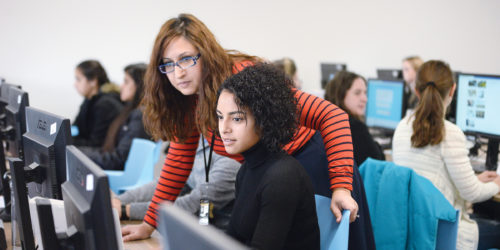Use Visuals Inclusively
Special thanks to Shermeen Khan, Manager Accessible Learning, for providing insights that made this teaching tip possible.
Visuals are inaccessible by default to non-visual learners. Doing the minimum work to ensure that lesson content is accessible (such as using accessibility checkers) may not provide a fully barrier-free learning experience for non-visual learners.
This teaching tip provides three ideas when using visuals in course materials to ensure learners with visual impairments are included. It applies to all course modes of delivery.
Gauge the Usefulness of the Visual
Research suggests that visuals presented in learning materials do not necessarily support learning (Mayer, 2005). Before defaulting to using a visual, ask yourself: what are the learning goals of the visual I want to use? After that, determine whether your lesson goals require a visual for learners, or if they may be achieved another way.
Graphs, charts, and other complex visuals often require lengthy, detailed descriptions to recreate not only data but also the meaning behind the layout, hierarchy, and relationships among the data. Charts provide a particular challenge for non-visual learners. Learners using screen readers, an assistive technology that renders text and image content as speech, hear only one thing at a time; they must hold in their heads title information as row and column data are recited.
To avoid placing non-visual learners in this challenging situation, think creatively about how to represent data in a non-chart format. This will benefit non-visual learners and other students who may find complex visuals difficult to interpret.
Structure and Support Understanding
Visuals may fail to support learning when we don’t know what is happening in the minds of learners (Sung-Hee & Bolling, 2010). Students require structured and guided support when learning with visuals. It is critical to describe whatever you are showing, explaining to students what you want them to see and understand.
As well, always ask students to describe what they see and what stands out to them. Paraphrasing draws on the students’ own curiosities and asks them to put into words what they understand. Using this strategy, you are then able to provide constructive feedback and further guidance to them.
A non-visual learner will be able to participate in lessons when faculty explain visuals clearly and students verbalize what they are seeing. And, once again, a verbal approach to visual course content will be helpful for non-visual learners and other students.
Use Colourful Alt-Texts
Computers and screen readers cannot analyze an image and determine what the image presents. Alternative text, or alt-text, provides the content and function of the images within web-based content.
An alt-text description will let non-visual learners know that a visual is there. However, without an equivalent description, the alt-text will not enhance learners’ experience in any meaningful way. In fact, to avoid appearing biased, authors may write brief and bare alt-text descriptions whose neutrality does not capture the full impact of the image.
Alt-texts are not just for the blind (Utah State, 2020). Learners will benefit from descriptions that provide context and colour. As you write alt-texts, think of yourself as a narrator describing the visuals from the lens of what you want students to recognize as meaningful or relevant.

Use Verbal and Visual Content Together, Always
Images can enhance comprehension, and verbal and verbal content together will enhance each other. Going forward, strive to design and deliver inclusive course materials by 1. thinking through your goal for using visuals, 2. actively support students’ sense-making, and 3. describing visuals in ways that bring them to life for non-visual learners.
To learn more about writing alt-texts for different types of visuals, see WebAIM’s article on Alternative Text.
References
Mayer, R. E. (2005). Multimedia learning. New York, NY: Cambridge University Press.
Sung-Hee, Jin & Boling, E. (2010) Instructional Designer’s Intentions and Learners’ Perceptions of the Instructional Functions of Visuals in an e-Learning Context. Journal of Visual Literacy, 29(2), 143-166, DOI: 10.1080/23796529.2010.11674678
Utah State University’s Center for Persons with Disabilities. (2020). Alternative Text. WebAIM. https://webaim.org/techniques/alttext/#advanced



